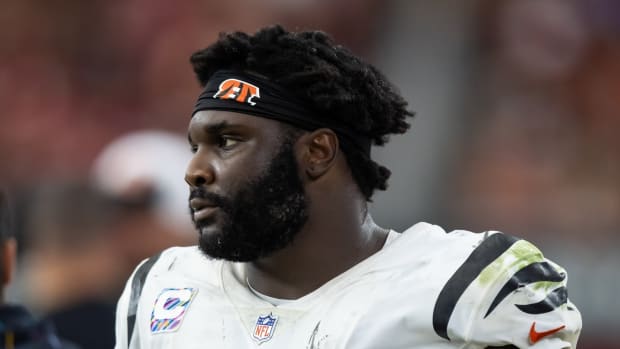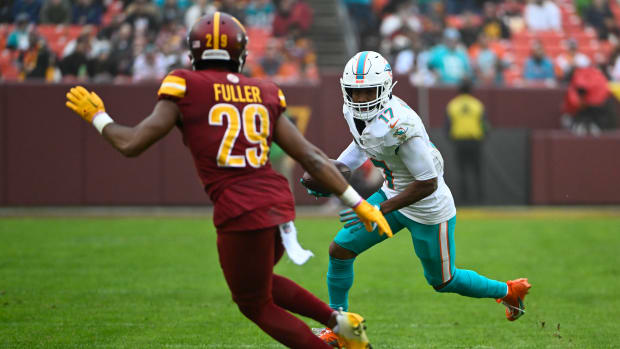8 Things to Know After Week 3: The NFL Is Wide-Open—the NFC East, Not So Much
Week 3 included the following: Justin Tucker’s 66-yard field goal ricocheting off the crossbar and dashing Lions’ fans hopes; the Jaguars summoning a 109-yard kick-six and still losing the game; and the latest terse post-game hug to be overanalyzed, this one between Matt LaFleur and Kyle Shanahan, one of whom has what the other wants (Aaron Rodgers). But now that the dust has settled on these wild moments, what are we left with? You’ve come to the right place...
1. The 2021 season is wide open. The defending champions in both conferences lost on Sunday. The teams that beat them did so with a player acquired via trade in January (Matthew Stafford) and a second-year player (Justin Herbert). There are five 3–0 teams, and four of them are the Raiders, the Broncos, the Cardinals and the Panthers. Certainly, the any-given-Sunday quality of the NFL means that it’s always possible the Ravens could defeat the Chiefs one week, then need a field goal of unprecedented length to beat the Lions the next week. But after three weeks—and especially after a Sunday when both Tom Brady and Patrick Mahomes, who account for six of the 10 starting QB slots in the last five Super Bowls, lost—this season feels full of possibilities outside the chalk picks.
2. The NFC East belongs to the Cowboys. The other three teams are off to a combined 2–7 start. Philadelphia and Washington are in transition, while the Giants seem stuck in neutral. Meanwhile, Dak Prescott is looking good in his return, the Cowboys hung with the defending champion Bucs and beat the upstart Chargers, and the defense is improved from last year (not that there was anywhere to go but up). But if Dallas wants to make noise beyond the NFL’s worst division, Mike McCarthy might want to designate a game management coach. Not calling a timeout at the end of the first half cost Dallas a possession, and in weeks when they are not playing NFC East opponents, that kind of mistake can change the outcome of the game.
3. Get ready for “Just Add QB” to be the new team-building trend. Cue the late-night infomercial: Feeling restless? Undervalued? Like your organization either doesn’t know what it takes to win, or stubbornly refuses to give it to you? You’re not alone. Protect your career by devising an exit strategy from your current organization and landing on a team that just needs you to win. Who has time for roster rebuilds, or trying to compensate for too many draft misses? Get out of town! For more information on Just Add QB, see: Tom Brady and Matthew Stafford.
Brady and Stafford took different routes to their new teams, Brady allowing himself to become a free agent, and Stafford asking for a trade. And their circumstances on their previous teams, obviously, were incredibly different. But Brady’s success in winning a Super Bowl his first season in Tampa Bay no doubt influenced franchise QBs to consider the possibility of playing somewhere else other than their current franchises. And now Stafford’s instant success with his new team may stoke that fire even more.
4. Davante Adams was in the blue medical tent for about one minute. The league released a statement through NFL Media Monday morning, saying that “all concussion protocols were fully followed.” They added that Adams was cleared by both the unaffiliated neurotrauma consultant and by the team doctor, and he was monitored by the Packers medical staff through the rest of the game. Adams said post-game that he did not suffer a concussion, and that while he lingered on the ground after the scary-looking collision with 49ers safety Jimmie Ward, he was mostly trying to catch his breath. Still, it’s worth looking back at the timeline. After Ward crashed into Adams’s chin with the side of his helmet, Adams was on the ground for about a minute before the broadcast cut to commercial. After the break, NBC’s Al Michaels said Adams was down for about two minutes before he began walking to the sideline. The elapsed time between when Adams entered the blue medical tent and when he was shown with his helmet on, jogging back onto the field was about 75 seconds, so it’s fair to extrapolate that his time being evaluated in the tent was about one minute. Post-game, Adams said that they began evaluating him on the field but told him “they had to go in the tent, check me out,” which indicates he was undergoing a sideline concussion evaluation. If that indeed was the case, there are a lot of steps to get through in one minute: 1. Checking for no-go criteria: loss of consciousness, gross motor instability, confusion and amnesia. 2. Inquiry about what happened. 3. Review of concussion signs and symptoms. 4. All Maddock’s questions, five basic questions such as “Where are we?” and “What quarter is it right now?” and 6. Focused neurological exam, including evaluating the cervical spine, speech, gait and eye movements. It’s possible that, because Adams showed no concerning symptoms, the medical professionals were able to breeze through their sideline assessment. But given all this, it’s no wonder there were questions about Adams returning after just one play and one timeout, and a more detailed statement on the steps he went through could have helped with public confidence in the NFL’s assertion that all protocols were followed.
5. There’s a common thread in Patrick Mahomes’ interceptions. We’ll ignore the first of Mahomes’s two picks Sunday, which came on a no-look pass that was a little behind his receiver, but still a catchable ball. But each of his other two interceptions this season, each of which played a role in the Chiefs’ two losses, occurred on a third-and-long when he seemed to sense the pocket collapsing and moved around to make something out of the play. Baltimore sent a three-man rush, but seemed to account for Mahomes’s tendency to step up in the pocket and extend the play by using Odafe Owah as a delayed fourth pass rusher. As soon as there was any crowding around Mahomes, he stepped up, right into Odafe, and made the ill-advised decision to try to get rid of the ball. Interception. On Sunday, the Chargers rushed four on the third-and-8 with 1:55 to play. L.A. ran a stunt against the left side of the Chiefs’ line, and Jerry Tillery pushed back left tackle Orlando Brown Jr. before falling down while trying to go outside of him. Meanwhile, the Chiefs looked to give Lucas Niang help on the right side against Joey Bosa, with running back Clyde Edwards-Helaire chipping him before going out on a route. The second when Mahomes took off to his right was when Bosa was pushing back Niang right in his vision. Mahomes pointed to Travis Kelce and danced around for about four seconds until Bosa and Christian Covington had come off their blocks to close in on him. He threw off his back foot, and the pass intended for Kelce was too long. Interception. With all the focus on the Chiefs needing to fix their offensive line after the Super Bowl loss, perhaps not enough attention was paid to the difficulty of breaking in five new starters, who are blocking for a player who has the physical abilities to make throws that defy logic. What we have seen so far this season looks a lot like an offensive line that has still not coalesced, combined with a QB who doesn’t seem to yet trust his blockers, and sometimes tries too hard to save the day because he has done it so many times before.
Watch NFL games online all season long with fuboTV: Start with a 7-day free trial!
6. The Steelers’ 2021 strategy had a big hole: the offensive line. The Steelers brought 39-year-old Ben Roethlisberger back for one more go. They made a change at offensive coordinator, with a promise of more misdirection and motions. They drafted a very good running back in the first round. They did all of this without investing in the unit that would make it all work, the offensive line. The Steelers lost four starters in the offseason: Maurkice Pouncey (retired), Matt Feiler and Alejandro Villanueva (free agency), and David DeCastro (cut). They didn’t take a lineman in the draft until the third and fourth rounds, and signed one of their starters, Trai Turner, in June. Najee Harris, the Alabama back, was selected to help Pittsburgh’s league-worst running game, but per Pro Football Focus, he’s been hit at or behind the line of scrimmage on 70% of his carries, the highest rate in the NFL. Roethlisberger is getting the ball out faster than any QB in the NFL, with an average of just 2.35 seconds from snap to throw, per NFL’s NextGen Stats. Injuries in Sunday’s loss to the Bengals only compounded Pittsburgh’s struggles up front. If things don’t improve, this could be a potentially fatal flaw in what is looking a lot like Roethlisberger’s final act in Pittsburgh.
7. Matt Nagy appears to be a man without a plan. Nagy has been adamant that, when healthy, Andy Dalton is his starter. But when Dalton got injured in the second game of the season, rookie Justin Fields became the starter. Either you commit to sitting the rookie and let him learn, or you create a path for him to play and be successful. So far, Nagy has done neither, as evidenced by Chicago’s 47 yards of total offense in the loss to Cleveland—a referendum on the coach, not the rookie. Now, Nagy has said that either Dalton (still healing from a knee injury), Fields (hand injury) or Nick Foles (healthy) could start this week. It’s understandable that Nagy may have had reservations about playing Fields early in part because of the Bears’ offensive line, which struggled mightily against a strong Cleveland front on Sunday, but Nagy’s game plan did little to mitigate what should have been an apparent mismatch and put his QB in harm’s way. The mismanagement of Fields’s debut is the kind of thing that can stunt the development of young quarterbacks—and can spur ownership to think about a coaching change.
8. Cooper Kupp could win this year’s receiving title. This is not a bold take, given that Kupp currently leads the NFL in receiving yards. But it would have been a bold take in August. (Kupp had an ADP of 51st overall in fantasy leagues, according to Fantasy Pros, and 19th among receivers.) Kupp only has one 1,000-yard pro season, in 2019, the year after he tore his ACL. And we know that last year was a down year for the Rams offense, otherwise there wouldn’t have been a QB change. Our optimistic forecast for the Stafford-led Rams should have accounted that Kupp could runneth over. Sorry. But hey: He’s currently on pace for a 2,000-yard season.
More NFL coverage:
• Podcast: The Full Sunday Recap
• MAQB: Risk/Reward of the C.J. Henderson Trade
• MMQB: L.A.'s Rams and Chargers Knock Off Last Year's Super Bowl Teams
Sports Illustrated may receive compensation for some links to products and services on this website.




































